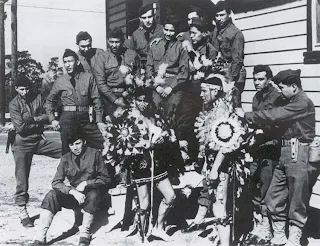Part 17 in the series Are Native Americans Relevant?
Native
Americans have supported militarily the interests of the ruling European
colonial governments and later the United States of America since the
1600s. They have served in Queen Anne’s
War, the French & Indian War, the American Revolution, the War of 1812, the
Civil War, the Spanish-American War, World War I, World War II, the Korean
Conflict, Vietnam, Desert Storm and Operation Iraqi Freedom. They have the highest record of service per
capita than any other ethnic group in the United States.
In
Native cultures adults, especially the men, have had the responsibility of
serving and protecting their people.
Integrated into the cultures was also treatment for post-traumatic
stress disorder. Warriors were
encouraged to reenact activities afterward as part of the celebration. Native people also used dream therapy and
sweat lodges to work out emotional problems.
Mohican
men served in Rogers’ Rangers during the French & Indian War. In the painting below, two Mohican scouts are behind Major Robert Rogers on the right.
During
the American Revolution, there were units of Lenape, Oneida and Stockbridge
warriors. Men served individually in
other units as well.
In
the War of 1812 1,000 Native American men served. There were more than 100 companies,
detachments or parties. They came from
the Choctaw, Creek, Cherokee, Shawnee, Chickasaw, Stockbridge tribes.
Native
Americans served in the U.S. military during the wars with the Seminoles and
Winnebagos, the Black Hawk War, the Creek War and the Mexican War.
In
the Civil War Native American men served in 3 Confederate Native units and 1
Union. Native men served individually as
well. Stand Watie, a Cherokee and
Confederate brigadier general, was the last officer to surrender.
In
World War I more than 12,000 Native American men served, 6,000 were
volunteers. The casualty rate was 5
times higher for Native men. This act of patriotism persuaded Congress to pass
the Indian Citizenship Act of 1924.
Approximately six hundred Native men from Oklahoma were assigned to the
142th infantry, 2nd Texas-Oklahoma National Guard Division. They served in France and 4 members were
awarded the Croix de Guerre.
By
the end of World War II, 24,521 reservation Natives, not officers, and 20,000
off-reservation Natives had served. This
was more than 10% of Native population, 1/3 of all able-bodied Native men. In some tribes the percentage as high as 70
percent. Several hundred Native women
served in the WACS, WAVS and Army Nurse Corps.
Together they were awarded 81 air medals, 62 silver stars, 57 bronze
stars, 44 distinguished flying crosses and 2 Congressional Medals of
Honor.
By
1945 150,000 Natives had participated in the war effort. Forty thousand Native women and men worked in
defense industries. They bought $50
million in war bonds.
Alaska natives were involved in territorial
defense. The Indian Service sent 1,119
of 7,000 employees into service.
Twenty-two employees died, 7 won Silver or Bronze Stars. In 1942 Japanese troops captured 45 Aleuts on
Altu. Only 24 returned.
In
the Korean Conflict, 10,000 Native men and women served. They came home to find Cowboy and Indian movies
popular and to see their cultures mocked and their representatives dying
regularly on the big screen. The
Navajos served at Taejon, Chonan, Chonai, the Kum River, Chochiwon. Pusan,
Sinanju, Asan and the Uijongbu Corridor.
More
than 42,000 Native Americans served in Vietnam.
More than 90 percent were volunteers.
They were more likely to see moderate to heavy combat.
Native
American military troops have seen active duty in Grenada, Panama, Somalia,
Persian Gulf.
In
1990 before Operation Desert Storm, 24,000 Natives men and women were in the
military. Approximately 3,000 Native
Americans served in the Gulf War.
By
2000 there were almost 190.000 Native military vets.
In
July 2005 24,000 Native Americans were serving in active duty, including almost
3,900 women. Native Americans were
approximately 2 percent of the active duty force, nearly 50 percent in the
Navy, 20 percent in the Marines, 19 percent in the Army and 12 percent in the
Air Force. Three percent of the Native
population aged 20-44 were serving, as compared to 2 percent of the total
American population.



Great post!
ReplyDeleteI love Native American History, despite the disturbing aspects.